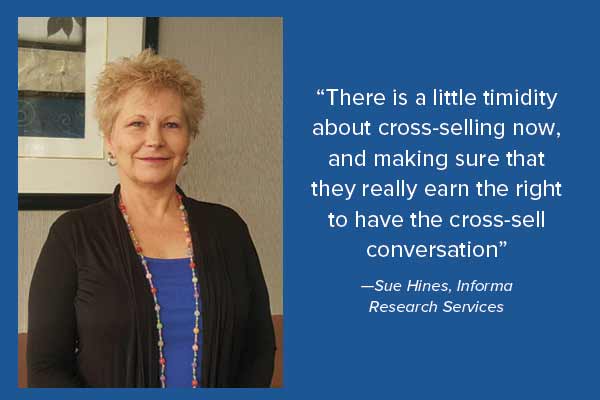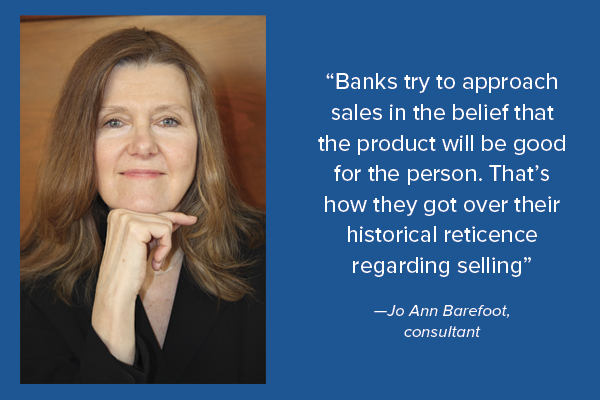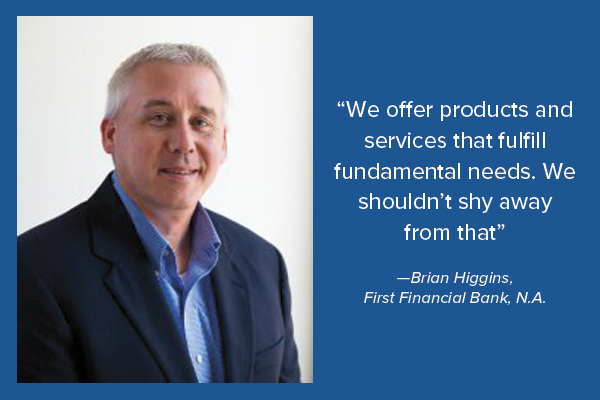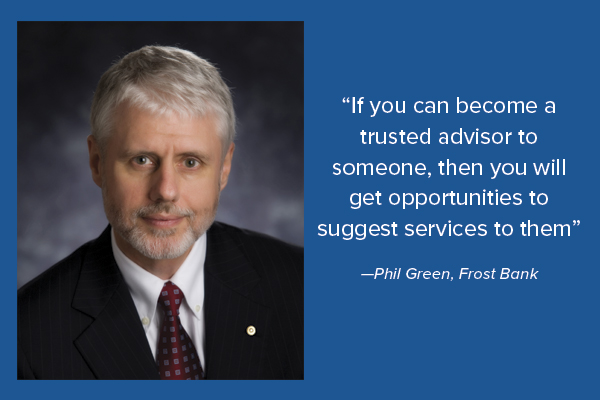Bank sales under scrutiny
“Sell” went from no-no to go-go to uh-oh. What’s right perspective on banks in the selling role?
- |
- Written by Steve Cocheo
 Selling's not abusive when done right. But what's "done right"? A selection of bankers and experts discuss this challenging question. When you've finished reading what they have to say, why not add your own views to the comment section at the story's conclusion?
Selling's not abusive when done right. But what's "done right"? A selection of bankers and experts discuss this challenging question. When you've finished reading what they have to say, why not add your own views to the comment section at the story's conclusion?
Forty-odd years ago, banks didn’t “sell.” Yes, they had new accounts representatives and calling officers. Some even admitted to having marketing directors. But no salesmen.
Sell was a dirty word.
That was something they did down at the used car lot. That was the business of people who pushed life insurance. That was something that, frankly, everybody else did. There was something plain unbankerly about selling.
But gradually, banks realized that sales and all the trappings—goals, incentive pay, and sales management—really were part of banking. Some accepted this grudgingly, some realistically, and some enthusiastically. One of the latter, although hardly the only one, was Wells Fargo.
This brings us to September 2016, when regulators slammed Wells Fargo—darling of analysts and others for its powerful cross-selling ratios—for a much-recounted series of sins. Congress weighed in. Heads and reputations rolled. In just days, a powerful corporate image went down the drain, and in the process, the concept of banks in the selling role got sucked toward the spiral.
• Is sell a dirty word in banking again?
• In a post-Wells Fargo settlement period, dare bankers utter that word?
• In a time when UDAAP has become, and remains, the law of the land, can selling in banks survive?
• And, looking forward, do these questions matter as much in the era of the virtual assistant? Where a human may have one eye on incentive pay, will an unpaid “bot” prove more trustworthy?
After you finish this article, we'd appreciate hearing your views on banks in the selling role in the comment section below.
In the wake of Wells
Even without the Wells affair, such questions are healthy for the banking industry to be asking. Asking them now may prove especially relevant. The industry appears to be on the verge of exiting the low-rate era. Just as rates begin to rise again, abundant cheap deposits may leave the bank.
Banks may be entering a period where selling becomes more important than ever.
This would be so even had Wells not happened. But in the wake of that unfortunate situation, banks anticipate close inspection of their sales practices by regulators. In late November, the Consumer Financial Protection Bureau connected the dots—for the minority of players who didn’t already get the message—in its Compliance Bulletin 2016-03, Detecting and Preventing Consumer Harm from Production Incentives.
Even before CFPB published its message, the Wells consent order represented a road map banks need to follow to make sure their sales and incentive practices are acceptable, observes Annette Tripp, partner at Bracewell LLP. The role of independent audit and the role of customer complaints are two messages to take from the order, according to Tripp.
Anyone who thinks banks didn’t take notice of the warnings implicit in the Wells case doesn’t talk to enough banks. Informa Research Services has been working with banks for decades, providing mystery shopping and other consumer research.

Informa executives have heard a good deal of feedback from bank clients. “There is a little timidity about cross-selling now, and making sure that they really earn the right to have the cross-sell conversation,” says Sue Hines, manager of customer engagement at Informa.
Chad Watkins, director, market intelligence, says there has been a blending of two traditional types of mystery shopping assignments: sales-oriented tests versus compliance-oriented ones. Now, concerned banks have the firm’s mystery shoppers evaluating both issues.
Reaction to the Wells settlements has been broad, according to Watkins. “At the end of the day, this is about brand and brand risk. Banks don’t have a monopoly. While Wells Fargo will be fine in the long run, if you are a smaller bank, you may not survive.” Such banks realize that they can’t afford a misstep.
More than ever, at least since the Great Recession, banks face being lumped into one group. Besides its client-focused research, Informa surveys 16,000 consumers annually. Watkins says recent research indicates consumers are well aware of what happened at Wells Fargo.
Community banks may see this as an opportunity to distance themselves from the giants.
Compliance consultant Patti Blenden sees the smaller banks’ challenge here as a double-edged sword.
On the one hand, she believes sales in a community bank, by its nature, will be cleaner, because the person on the other side of the desk may very well be a friend or neighbor, not an anonymous member of an endless stream of customers.
On the other hand, “for community banks, there’s nowhere to hide. They are clearly aware that everything they do is scrutinized closely. And there are only so many people in your community.”
Wells Fargo’s cross-selling prowess dazzled the industry, with everyone wondering how bankers hit their ambitious targets, says David Kerstein, president of Peak Performance Consulting Group.
One factor that Kerstein says hasn’t been discussed much is the potential influence of what he calls the “Wells alumni club,” a large group of people raised in a culture where “hitting your numbers every day, every week, every month” was paramount.
By his own rough research using LinkedIn, says Kerstein, there are at least 15,000 former Wells employees in positions at other banks. “So I wouldn’t be surprised if these practices didn’t show up in other places as well,” he concludes.
Do “sell” and “bank” fit in same sentence?
Veteran consultant, former regulator, and reg tech entrepreneur Jo Ann Barefoot has watched banks go through the long arc of their involvement in sales.
“Banks try to approach sales in the belief that the product will be good for the person,” says Barefoot. “That’s how they got over their historical reticence regarding selling.”

Considered this way, sales is seen not as exploitative, but as customer service. Many bankers take pride in matching customers with the right product, she says, avoiding what some call “the hard sell,” in favor of a more consultative role.
“We keep the conversation around how to solve the customer’s needs,” says Brian Higgins, first vice-president, digital and payments, at First Financial Bank, N.A. “Internally, we talk about selling the customer everything they need, but nothing more. Overall, we offer customers clarity, simplicity, and transparency.”
Monitoring and coaching represent important parts of the sales approach at $8.4 billion-assets First Financial, headquartered in Cincinnati. Higgins says management wants to be sure that bankers work the process, asking the questions that will bring out the customers’ needs. Ultimately, there is consideration of “what did the customer wind up buying from us?” he explains.
Adds Higgins, who came into banking four years ago after working in other parts of the financial services business: “One thing we are very clear on internally is we shouldn’t apologize for selling. We offer products and services that fulfill fundamental needs. We shouldn’t shy away from that.”

At Frost Bank, there’s a belief that the best sales effort is one that develops customer connections to the $29.6 billion-assets institution over time.
“We’re not product pushers; we’re relationship managers,” explains Phillip Green, chairman and CEO, and a 36-year veteran of the Texas organization. When relationships work, they naturally expand. “You get to grow with the customer,” Green explains. (Earlier this year, Frost was ranked highest in retail banking customer satisfaction in Texas by J.D. Power, for the seventh year in a row.)
Goal-setting comes up. Green acknowledges that “every company has goals. That’s just a natural part of business. It’s there, a goal to achieve.” However, he doesn’t see quotas and the like as helping that.
Instead, he says, supervisors are constantly asking staff, “Did you make calls to customers today? Did you reach out to a customer?”
“That’s what keeps a relationship strong,” points out Green. “If you can become a trusted advisor to someone, then you will get opportunities to suggest services to them. Relationship banking has a longer sales cycle, but when you succeed, it results in a higher level of customer satisfaction.”

“We look at sales as a service,” says Higgins. “If we are selling effectively, we are providing a good service to that consumer. If we are fulfilling a need they don’t have, then we are providing bad service.”
In fact, a common error may be in thinking of sales as a series of individual events, rather than as an ongoing process. The latter broadens the concept of “relationship.”
Dan Kleinman, of a sales consulting firm bearing his name, says a strong relationship is one in which the banker is not just suggesting products, but asking about needs the bank isn’t filling. That, and having a good enough handle on each customer’s behavior to know when he isn’t using a service he already has, and finding out why.
Frost’s Green notes that finding a customer who isn’t using the bank’s proprietary, mobile banking service is a big deal because the app improves convenience tremendously.
Finding the “line”
When the topic is sales, there is talk, inevitably, about efforts that “cross the line.” But where exactly is the line?
“It’s difficult to define that,” says Barefoot, a consultant. “But there needs to be a focus on customer service and customer centricism.”
Barefoot believes monitoring customer complaints can help banks steer the right course. “That’s one way to detect overly aggressive selling,” she says. When phrases like “That wasn’t fair!” or “I didn’t understand what I was being sold” begin to recur in complaints, steps must be taken.
Barefoot says she has no doubts that UDAAP, and CFPB’s use of it, has changed the industry.
“I know a lot of banks that felt that this was good,” Barefoot maintains. “It encouraged some soul searching and encouraged people to push back on some things that might not be beneficial to customers.”
Barefoot believes every bank should have a sales culture statement that managers and employees know of and understand to be real that says the bank will not sell customers any product that isn’t good for them. And anyone in a sales role should be trained to listen to cues that a prospect doesn’t like where a conversation is going.
“I have listened in to some sales calls in my work,” says Barefoot, “and sometimes the customer is trying to express reservations to the sales rep.”
The greatest concern in bank selling is the cross-sell, in Barefoot’s view. When a customer comes in to open an account of this kind or that, offering alternatives in that product category works. When the conversation moves beyond the initial idea, that’s a step beyond and should be treated with a tempering caution, according to Barefoot.
Peak Performance’s Kerstein suggests that employee complaints, explicitly or more likely in the form of some anonymous whistle-blower or similar process, should be taken very seriously. At Wells, he says, “complaints from employees about the sales program should have been a warning that something bad was going on.”
Complaints in general are much more important than reports about high rates of customer satisfaction, says Kerstein. “Talk to the 5% who aren’t happy,” he suggests. “You may find some patterns.”
Informa’s Hines says that banks ought to strive for customer satisfaction, but in today’s competitive picture, consider it only a beginning.
“Satisfaction is just cost of entry now,” Hines explains. In Informa’s work, high 90s out of 100 are common to most evaluations. Banks should want to be sure, she says, that trust is present; that customers feel the bank offers real value; and that what the bank provides relates to customers’ lives. “You really have to know that your bank is doing the right things,” Hines explains.
An interesting alternative view on what banks should be striving for in service comes from the Center for Financial Services Innovation: financial health.
John Thompson, senior vice-president, says that a recent study by the center found that 57% of the U.S. population is struggling financially. This goes beyond the unbanked and underbanked portions of the population. The report states that these Americans are having difficulty establishing a cushion for financial resilience, and ensuring financial security and mobility.
“What consumers are really looking for from financial institutions is health and stability, rather than getting rich,” explains Thompson. CFSI’s concept includes elements of improving financial literacy as well as banks stepping in to help consumers manage their affairs. In essence, the center sees a bank becoming a “financial Fitbit.”
Thompson says the long-term benefit to the bank is that “as the consumer’s financial health improves, so does their value to the institution.”
One caveat, however, according to Thompson, is that “it’s not like you can put this into the hands of your sales team.” Likewise, he says, a bank would have to make a sincere commitment to this concept for it to work. “If it becomes a veneer, it will fade,” he says. “Employees would see through that.”
Setting goals and measuring sales
Much thought goes into sales programs and their direct relative, sales incentive compensation. Yet the consensus of experts interviewed is that much misguided thinking has gone into the setting of sales goals, the metrics chosen, the timing of incentives, and how employees and managers are evaluated for their sales performance.
First Financial’s Higgins boils down concisely one key problem: “Banking for too long has been product-focused. ‘We have to sell widgets.’ Our thinking shouldn’t always be about ‘credit card Tuesday’ or the big red button that says ‘buy now’.”
“The more you measure people on the basis of raw numbers and the more you push them hard for those kinds of results, the more you’ll get behaviors that are not desirable,” points out Peak Performance’s Kerstein.
Sales expert Kleinman blames the typical bank promotion process for engendering a simplistic view of selling. Bankers who prove adept at sales often wind up being promoted to being—whatever the bankerly title may be—sales managers. The problem is that they have selling skills, but perhaps not analytical skills or tools.
Lacking those, “they fall back on ‘Sell more! Sell more!’” says Kleinman. A bank that speaks of a more enlightened viewpoint but that still falls back on “sell more” sends employees the wrong message. “Employees pick up on it when you are just ‘doing something for the tourists’,” says Kleinman.
Selling “more” is a curious concept. At first blush, more would seem to imply more profits. But for many banking services, the initial sale means far less than does usage of the product and retention of the relationship.
Take a consumer line of credit. Until it is drawn on, the bank isn’t making a dime, so why pay an incentive for that? Informa’s Watkins shakes his head over the many accounts opened at Wells unbeknownst to the account holders. Why didn’t anyone point out, Watkins asks, how many accounts the bank had on its books that were basically dormant? “Why would you measure accounts rather than adoption and usage?” he adds.
This comes down to the issue of quality versus quantity.
“A bank can’t drop its focus on quality growth,” says Kleinman. Ultimately, the value of the entire relationship with a customer produces a net gain or net loss for the bank. Focusing on one account, one kind of metric by itself, does the bank no good.
Ultimately, retention means more to Kleinman than initial sales. In his own view, that means that banking companies shouldn’t be paying commissions on sales. The industry’s products are not “products” typically, but services, and service implies the ongoing relationship already spoken of.
Frost’s Green says incentives play a small part in the compensation of those employees in sales roles. “We make our base pay a little higher,” he explains.
Setting goals isn’t done at the individual level, but at the branch and market levels at First Financial, notes Higgins. The contributions made to the whole by individuals is reviewed, he adds, but the overall idea is to encourage teamwork.
Compensation: green and otherwise
Before becoming a banking compensation expert for Crowe Horwath LLP, managing director Timothy Reimink spent years in banking. Among other things, he oversaw branch systems and he saw the lengths that branch managers would go to make quotas. One expense that always gave him a chuckle was the branch manager who charged the promotion budget for cans of Coca-Cola that employees would give to drive-through customers to get them to hear a message about credit cards.
According to Reimink, there are some best practices for the sales incentive pay system:
• Multiple metrics. Banks should select a set of meaningful metrics—not making the program dependent on one factor. They should present a balanced picture of sales performance.
• Judge the details. Moving product should be balanced by performance related to that. Does the sales ace handle documentation properly? Do the loans made generally perform satisfactorily?
• Broaden program qualifications. Sales staff shouldn’t be evaluated solely on the basis of sales. Reimink suggests that overall job performance should be taken into account.
Often, bank sales programs focus on the performance of the individual banker. Reimink says that can be trouble when a top performer’s “halo effect” sets him up for different treatment from other employees.
Another practice with pros and cons is “stack ranking.” Reimink understands that the idea here—of letting every sales staffer see where he ranks versus others—is supposed to tap into competitive spirit. However, Reimink warns that public rankings can undermine teamwork.
“It doesn’t create an environment where everyone is cheering for everyone else,” the consultant explains. Ultimately, management has to consider the kind of behavior compensation incents. When the individual becomes the focus of a program, “top performers will hold very tightly to their customer base,” Reimink explains.
Reimink suggests that some organizations lean too heavily on incentive pay for sales. Kleinman agrees. He says organizations can sometimes overpay, which begs the question of clawbacks—taking money back where things don’t pan out. Reimink says this has been mostly an upper- and senior-management issue, “though it is trickling down in areas where the impact of employee behavior on result is not always immediately seen.”
Is robo selling better?
Sales expert Kleinman is based in San Francisco near Valencia Street, once a blue-collar neighborhood, but now given over to trendy coffee shops where millennial business people can imbibe caffeine and plug in to work off laptops all day.
“These are people who get together and don’t really communicate except through machines,” maintains Kleinman. His question is: How do banks bring sales and service cultures, as practiced by banks, to this millennial generation that hardly goes near a bank and may hardly talk to other people?
Putting aside the whole issue of the future of the branch versus digital banking, will technology render the concern over sales moot? Is the app the solution to such problems? It is said that Amazon’s pages are personalized by 26 different factors. Will the algorithm—uncompensated, unemotional, and lacking a family, mortgage, or expenses—replace the fallible human?
Maybe. But probably not.
Informa’s Hines says her work observations demonstrate that “‘Let me do it myself’ is winning. For banks, the number one lesson in Amazon is that people are happy to serve themselves. They want convenience.” Banks that don’t climb aboard that train, Hines points out, will see attrition.
Will the emerging fields of artificial intelligence and machine learning be a magic wand that makes all sales pure and customer centric?
Hines doubts it. So long as humans program apps, the human element won’t be absent from sales.
Consultant Barefoot, while a believer in the power of good in technology, says it’s much too early to decide the ultimate impact of behavioral science on customer service. On the other hand, she hypothesizes that as virtual assistants become more powerful and adept, they will become the tech equivalent of a biological membrane, “something that keeps out the bad stuff and lets in the good stuff.” A great offer with no strings will pass through to the human owning the mobile device. Fishy deals won’t meet human eyes, she suggests.
Higgins says First Financial isn’t bringing customers an Amazonian 26 points of differentiation, but the bank has worked hard over recent years to build more sophisticated approaches to understanding customer needs. What concerns Higgins more is that customers have become much more sophisticated about online account openings than many banks are.
“We risk that gap increasing,” Higgins says.
Ultimately, Higgins suggests, as geography becomes less important, banks will adapt responsive design in their electronic face to customers. This won’t just be a matter of adapting to each potential device that a customer may be using, but responding to individual preferences. The comparatively homogenous neighborhood of a branch will give way to the “neighborhood” of one person who wants the bank to serve him his way.
Yet sales culture will continue to matter, Higgins believes, because customers will still prefer human interaction for many types of services, such as mortgages and 401(k) programs.
This article originally appeared as the cover story in the December 2016-January 2017 Banking Exchange magazine.
Tagged under Human Resources, Management, Retail Banking, Revenue, Feature, Feature3,













